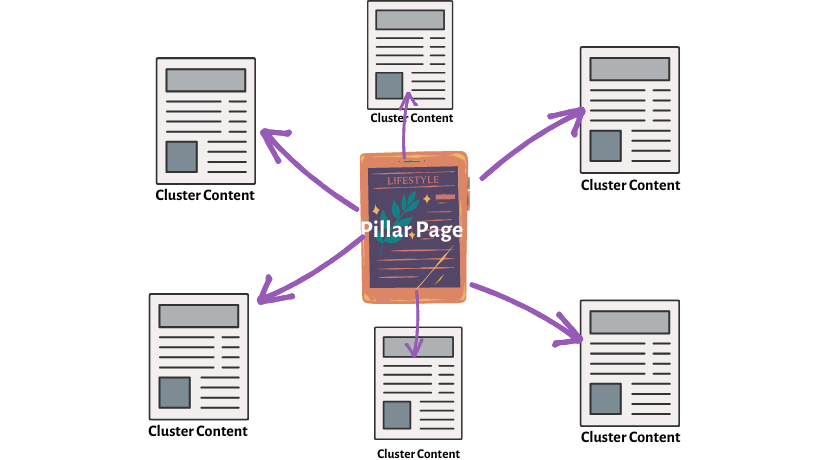Topic Clusters: How to Use Topic Clusters to Boost SEO in 2023
The concept of SEO topic clusters isn’t new. It is not a secret weapon that many content strategists and SEO specialists are using to improve rankings and generate more organic traffic.
If you still publish content based solely on individual keywords, it might be time to start think about the topic cluster strategy.
In this post, we’re going to cover exactly what topic clusters are, how topic clusters can improve your SEO, and most importantly, how to create a topic cluster strategy.

Contents
- What are Topic Clusters?
- What Are the Main Components of a Topic Cluster?
- How Topic Clusters Can Improve SEO?
- How to Create a Topic Cluster SEO Strategy?
- Step 1. Decide Your Core Topic
- Step 2. Do Keyword Research Around Topics & Search Intent
- Step 3. Outline Pillar and Topic Cluster Structure for Core Topic
- Step 4. Review Your Current Content
- Step 5. Write Your Cluster Pages
- Step 6. Write Your Pillar Pages
- Step 7. Add Internal Links Between Pillars and Clusters
- Wrap Up: Start Incorporating Topic Clusters in Your Content Strategy
What are Topic Clusters?
Topic clusters (or content clusters) are groups of content assets on a website that are all centered on a related topic. As a whole, these pages offer comprehensive coverage of a specific subject. That enables visitors to satisfy their search query while visiting your site.
What Are the Main Components of a Topic Cluster?
Usually, a topic cluster consists of three components:
- A pillar page on a core topic. Pillar page is our hub for a specific topic. This page is generally broad and link to multiple topic cluster pages.
- “Cluster” pages that cover related topics in more depth. A cluster page tends to have a narrower focus on a specific user intent. It answers a specific question about your broad topic and links back to the main pillar page.
- Strategically-placed internal links. Links from the cluster pages to the pillar pages are a signal to search engines that the pillar page is the most important in the group. Links from an authoritative pillar to cluster content pass authority to the rest of the cluster.
Make it simpler: Every topic cluster is built around a piece of pillar content (or a pillar page), and then topic cluster content explores a broader subject with more detail, nuance, and specificity.

How Topic Clusters Can Improve SEO?
Once upon a time, marketers could win by targeting a single keyword per page. Now, the search engine optimization strategy focuses on topics rather than keywords. That’s all because of search engines are better at understanding semantically related concepts and Google wants to provide users with authoritative and trustworthy results. Collectively, this means sites that feature multiple pieces of content thoroughly addressing a given topic will generally outperform those with fewer, less authoritative pieces.
Then, in what ways topic clusters boost your SEO? Topic clusters can have a significant impact on SEO results in three ways.
- Firstly, topic clusters help search engines better understand the hierarchy of your website. As such, they may help search engines see your site as an authority on a specific subject.
- Secondly, topic cluster helps you increase the opportunity to have several pages on the first page of Google for a topic and its adjacent searches. As you create a large set of pages around a core topic, you will naturally be visible across multiple search queries and intent. It increases your chance to be found organically for a specific topic.
- Thirdly, when one piece of your cluster content does well, every interlinked page does better, too. Creating content around a topic often improves the search rankings of other similar content that’s already on your site.
How to Create a Topic Cluster SEO Strategy?
If you’re interested in using a topic cluster or your current topic cluster strategy is not working as you expected, do not despair. Here’s the detail guide for how to create a topic cluster strategy.
Step 1. Decide Your Core Topic
Start with figuring out what topic you want to be a thought leader on, then build content around this topic to help prospects grow to trust you and your brand.
These are some guidelines to help you determine good topics:
- Relevant to your brand. They should relate to the product or service you’re selling.
- Relevant to your customers. They match the keywords that people search for.
- Solve a pain point. They offer solutions to problems your potential customers encounter.
- Answer a question thoroughly. They provide useful and comprehensive information that establishes your expertise on the subject.
Step 2. Do Keyword Research Around Topics & Search Intent
Topic clusters are about creating several content pieces with different yet revolving around one core topic. For that, you need one core keyword for a pillar article and several related terms for supporting content.
You can use some keyword research tools to do research for the topic cluster. Ahrefs, SEMrush, and AnswerThePublic are only a few to consider.
When searching for the right keywords to use in a topic cluster, you can also “spy” on competitors. Therefore, you’ll find what keywords you might miss for rankings.
Step 3. Outline Pillar and Topic Cluster Structure for Core Topic
Now you should have a healthy list of keywords on a topic you previously didn’t know anything about. To use them for building effective topic clusters, we’ll need to group them together by topic. This involves:
- Identifying a core keyword.
- Listing related keywords around sub-topics.
When it comes to choosing the subtopics, think about all the questions your targeting users will have about your chosen topic. Focusing on your readers when choosing your subtopics ensures you’re creating content that’s relevant and helpful to them.
Step 4. Review Your Current Content
Since this is a core topic to your business, you should already have a web page and supporting content on this subject. Conduct a content audit to see how much content and how many web pages you have in place already. Then, organize and match it to your chosen topic clusters.
Step 5. Write Your Cluster Pages
You have found subtopics within your topic clusters that you haven’t created content for. Now it’s time to write the cluster content.
Writing cluster pages is similar to writing a standard blog post with two exceptions:
- Do not mention anything in detail covered on another cluster page.
- Dive deep into the subtopic, focusing heavily on the keyword
Step 6. Write Your Pillar Pages
I recommend writing the pillar page at the end. It is like writing the glossary of a book.
Better to do it once you know all the content.
Again, writing a pillar page is similar to writing a blog post with a few differences. Pillar pages are:
- An overview of one broad topic (Don’t go into too much detail about one aspect of the topic. Link to the cluster pages to explain subtopics in detail.)
- Usually long-form (3,000-plus words)
Step 7. Add Internal Links Between Pillars and Clusters
Now, this is HUGE and something you cannot forget.
As you’re laying out all your cluster pages, it is critical that you link them back to the main pillar page. At the same time, you need to make sure your main pillar page also links out to all of your subtopic pages. This is what ties all your topic cluster efforts together and tells Google how your pages are related to one another.
Wrap Up: Start Incorporating Topic Clusters in Your Content Strategy
The topic cluster model is a fantastic way to organize your content and boost organic traffic. If you have already spend a significant amount of time on content creation, then why not go further to organize them in topic cluster model?
When you fully adopt a topic cluster model, your content marketing strategy will become more organized, efficient, and sophisticated.
So, what are you waiting for!
